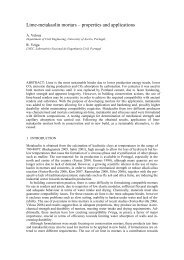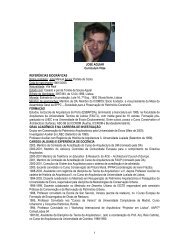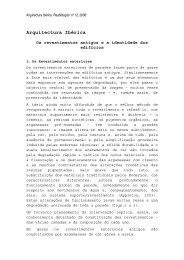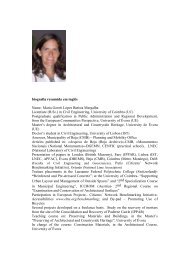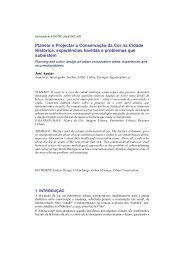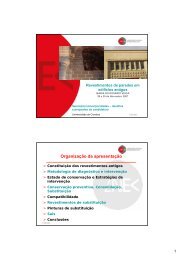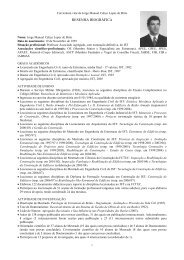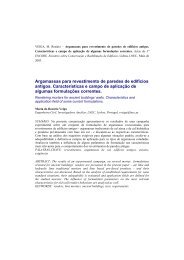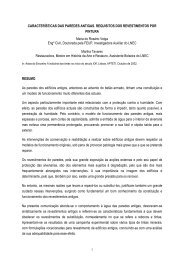Substitution mortars for application in historical buildings
Substitution mortars for application in historical buildings
Substitution mortars for application in historical buildings
You also want an ePaper? Increase the reach of your titles
YUMPU automatically turns print PDFs into web optimized ePapers that Google loves.
<strong>Substitution</strong> <strong>mortars</strong> <strong>for</strong> <strong>application</strong> <strong>in</strong> <strong>historical</strong> build<strong>in</strong>gs exposed to<br />
the sea environment. Analysis of the viability of several types of<br />
compositions<br />
Veiga R. 1 , Fragata A. 2 , Velosa A. 3 , Magalhães A. 4 , Margalha G. 5<br />
1<br />
Veiga R., Laboratório Nacional de Engenharia Civil (LNEC), Lisboa, Portugal, rveiga@lnec.pt<br />
2<br />
Fragata A.,Laboratório Nacional de Engenharia Civil (LNEC), Lisboa, Portugal, afragata@lnec.pt<br />
3<br />
Velosa A., University of Aveiro, Aveiro, MIA, Portugal, avelosa@ua.pt<br />
4 Magalhães A., Laboratório Nacional de Engenharia Civil (LNEC), Lisboa, Portugal,<br />
acristian@lnec.pt<br />
5 Margalha G., Câmara Municipal de Beja, Beja, Portugal, mgoreti@netvisão.pt<br />
Abstract<br />
In Portugal, many <strong>historical</strong> build<strong>in</strong>gs <strong>in</strong> coastal areas have renders based on lime. Despite the<br />
severity of the sea environment – high content <strong>in</strong> soluble salts, namely chlorides, and high relative<br />
humidity - these old <strong>mortars</strong> have proved to be sufficiently resistant and durable. They are<br />
frequently <strong>in</strong> good condition, show<strong>in</strong>g especially good cohesion and adherence to the background,<br />
although they often present degradation on the surface, as a result of biological colonization,<br />
efflorescences and superficial cracks. Interventions based on substitution of old <strong>mortars</strong> <strong>for</strong><br />
<strong>in</strong>compatible new ones can produce the premature degradation of masonries through cohesion<br />
and adherence loss or contam<strong>in</strong>ation with soluble salts that previously did not exist. In this context,<br />
the study of compatible <strong>mortars</strong> with old and durable renders exposed to sea environment<br />
becomes fundamental, not only <strong>for</strong> the build<strong>in</strong>g image but also <strong>for</strong> the ma<strong>in</strong>tenance of its <strong>in</strong>tegrity.<br />
The purpose of this paper is to present a collection of different lime based <strong>mortars</strong> ma<strong>in</strong><br />
characteristics, studied <strong>in</strong> LNEC, <strong>for</strong> substitution of old <strong>mortars</strong>: air lime <strong>mortars</strong>, air lime and<br />
cement <strong>mortars</strong>, air lime and hydraulic lime <strong>mortars</strong>, air lime <strong>mortars</strong> with pozzolanic additions and<br />
with other additions and admixtures. The ma<strong>in</strong> physical characteristics - capillary absorption and<br />
water vapour permeability - and mechanical characteristics – flexural and compressive strength<br />
and dynamic elastic modulus - of these <strong>mortars</strong> are analyzed and compared. Ranges of values<br />
obta<strong>in</strong>ed <strong>for</strong> each type of composition are def<strong>in</strong>ed and the viability of those <strong>application</strong>s <strong>in</strong> sea<br />
environment is studied. Some procedures are taken <strong>in</strong>to consideration concern<strong>in</strong>g the <strong>for</strong>mulation<br />
and <strong>application</strong> care <strong>in</strong> order to improve the <strong>mortars</strong>’ per<strong>for</strong>mance and durability to be used <strong>in</strong><br />
<strong>historical</strong> build<strong>in</strong>gs <strong>in</strong> coastal areas.<br />
Keywords: additions, conservation, durability, lime, mortar, pozzolans.<br />
1. Introduction<br />
Renders are vulnerable constituent of constructions. They are used as decorative and protective<br />
coats, act<strong>in</strong>g as sacrificial layers. The renders of <strong>historical</strong> build<strong>in</strong>gs <strong>in</strong> coastal areas have been<br />
subjected, all over the years, to an aggressive environment of salty mist, high humidity, hot sun,<br />
dry w<strong>in</strong>d and sometimes, <strong>in</strong> <strong>for</strong>tresses and lighthouses (fig. 1), even to waves’ strength, Nowadays,<br />
these old lime based renders appear <strong>in</strong> generally good conditions but they usually present some<br />
localised degradation – superficial cracks, detachments, erosion, loss of cohesion – and so there is<br />
a need of repair and partial substitution. The lack of knowledge about these renders, as a material,<br />
conservation techniques and ma<strong>in</strong>tenance pr<strong>in</strong>ciples, are factors that can also promote<br />
degradation.<br />
In conservation action, the priority is to achieve compatibility and optimize the durability of the<br />
whole build<strong>in</strong>g (Veiga et al. 2007a). The compatibility should be <strong>in</strong> terms of chemical compatibility
etween the new renders and the old materials, physical compatibility – related with similar water<br />
transport and thermal properties – and mechanical compatibility – associated with de<strong>for</strong>mability<br />
and tension state. A strong and rigid repair mortar restra<strong>in</strong>s movement and transmits stresses that<br />
can orig<strong>in</strong>ate the degradation of the masonry; an impermeable mortar keeps the water <strong>in</strong>side<br />
masonry or <strong>for</strong>ces its transport through the more permeable old mortar and masonry.<br />
S<strong>in</strong>ce the appearance of Portland cement, there is a disuse of lime-based <strong>mortars</strong>, consequently<br />
their traditional manufacture and <strong>application</strong> has almost been lost (Lanas and Alvarez 2003).<br />
The <strong>in</strong>crease of the use of lime-based <strong>mortars</strong> <strong>in</strong> conservations works, <strong>in</strong> order to achieve the<br />
required compatibility, justifies the research about these materials, as they present nowadays<br />
some problems <strong>in</strong> terms of durability and protection to water (Magalhães et al. 2006). The choice<br />
of adequate materials to be used as conservation <strong>mortars</strong> is fundamental to the success of the<br />
conservation action.<br />
Lime based <strong>mortars</strong> need a long time <strong>for</strong> carbonation, thus a cur<strong>in</strong>g period of 28 days is not<br />
enough to get significant test results. The b<strong>in</strong>der, namely the k<strong>in</strong>d of lime and its preparation, as<br />
well as the additions used, <strong>in</strong>fluence greatly the mortar characteristics. The gra<strong>in</strong> size distribution<br />
and the nature of the aggregate are also important factors. An adequate gra<strong>in</strong> size distribution can<br />
allow <strong>for</strong> the development of high strength. With siliceous aggregate the reactive silica can react<br />
with lime, produc<strong>in</strong>g CSH compounds <strong>in</strong> the <strong>in</strong>terface that improve mortar strength (Lanas and<br />
Alvarez 2003).<br />
Natural and artificial pozzolans are important additions used s<strong>in</strong>ce Roman times to improve the<br />
resistance to the action of water and the durability of lime based <strong>mortars</strong>. There are many <strong>in</strong>tr<strong>in</strong>sic<br />
factors that <strong>in</strong>fluence the pozzolan’s reactivity: active silica content, gra<strong>in</strong> size distribution, specific<br />
surface. In terms of artificial pozzolans some other parameters play a significant role to their<br />
reactivity, such as the calc<strong>in</strong>ation temperature (Moropoulo et al. 2004).<br />
Capillary absorption is used as an <strong>in</strong>dicative of the vulnerability to degradation of build<strong>in</strong>g materials<br />
and it is a consequence of the porous nature of build<strong>in</strong>g materials and their exposition to<br />
environmental conditions (Arandigoyen et al. 2005).<br />
Many renders’ solutions are be<strong>in</strong>g recommended <strong>for</strong> old build<strong>in</strong>gs. However, some of them present<br />
some problems due to their <strong>in</strong>compatibility with the background and with existent surround<strong>in</strong>g<br />
<strong>mortars</strong> or due to <strong>in</strong>adequacy to particular environment conditions. In this paper, ranges of values<br />
obta<strong>in</strong>ed <strong>in</strong> previous work carried out <strong>in</strong> LNEC are presented, with different b<strong>in</strong>ders and aggregates<br />
and with diverse cur<strong>in</strong>g conditions.<br />
Fig. 1 – Fortresses <strong>in</strong> the coast of Lisbon<br />
2. Requirements<br />
In order to achieve the desired compatibility related with the <strong>mortars</strong> per<strong>for</strong>mance to water enter<strong>in</strong>g<br />
the substrate and concern<strong>in</strong>g adequate mechanical characteristics, without transference of <strong>for</strong>ces
to the background masonry, general requirements were established, tak<strong>in</strong>g <strong>in</strong>to account both the<br />
characteristics of old <strong>mortars</strong> and the properties of the most common <strong>historical</strong> masonry <strong>in</strong><br />
Portugal (Veiga et al., 2001; Veiga and Carvalho, 2002). The results obta<strong>in</strong>ed <strong>for</strong> the different lime<br />
based <strong>mortars</strong> of the present study will be compared with those requirements, presented <strong>in</strong> table 1.<br />
Table. 1 General requirements concern<strong>in</strong>g some characteristics <strong>for</strong> render<strong>in</strong>g and repo<strong>in</strong>t<strong>in</strong>g<br />
substitution <strong>mortars</strong> <strong>for</strong> ancient build<strong>in</strong>gs<br />
Type of render<br />
Mechanical characteristics at 90 days<br />
(N/mm 2 )<br />
Water behaviour<br />
Rt Rc E Sd (m) C (kg/m 2 .m<strong>in</strong> 1/2 )<br />
Exterior render 0,2 – 0,7 0,4 – 2,5 2000 - 5000 < 0,08 < 1,5; > 1,0<br />
Interior render 0,2 – 0,7 0,4 – 2,5 2000 - 5000 < 0,10 -<br />
Repo<strong>in</strong>t<strong>in</strong>g mortar 0,4 – 0,8 0,6 – 3,0 3000 - 6000 < 0,10 < 1,5; > 1,0<br />
Build<strong>in</strong>gs <strong>in</strong> coastal areas are subjected to severe actions, and renders, whose ma<strong>in</strong> function is the<br />
protection of walls, are particularly exposed. Samples collected from several constructions located<br />
<strong>in</strong> Lisbon and coastal surround<strong>in</strong>gs show clearly that very resistant and durable materials were<br />
used (Santos Silva, 2002), usually based <strong>in</strong> air lime and additions or aggregates that promoted<br />
pozzolanic reactions. Thus, the <strong>mortars</strong> to use <strong>in</strong> repair and replacement <strong>in</strong>terventions must have<br />
special properties to assure durability to the referred actions, as well as keep<strong>in</strong>g compatibility<br />
characteristics. The <strong>mortars</strong> must have high mechanical strength to resist erosion of sea w<strong>in</strong>d and<br />
salt crystallization pressure, moderate elasticity modulus to accommodate de<strong>for</strong>mations due to<br />
sudden thermic variations, moderate capillary coefficient and high water vapour permeability to<br />
retard the entrance of water and allow <strong>for</strong> quick dry<strong>in</strong>g. Besides, they should not have high<br />
contents of salts, to avoid the <strong>in</strong>crease of salt contam<strong>in</strong>ation <strong>in</strong>to the walls. Some studies (Charola,<br />
2000; Gonçalves, 2007) refer a synergetic effect of chlorides and sulphates that imply an<br />
aggravation of salt attack when both are present, so the contam<strong>in</strong>ation with sulphates (present <strong>in</strong><br />
cement and some k<strong>in</strong>ds of hydraulic limes) may be particularly harmful.<br />
3. Experimental work<br />
3.1 Mortar <strong>for</strong>mulation and condition<strong>in</strong>g<br />
The studied <strong>mortars</strong> were <strong>for</strong>mulated with: cement, cement and air lime, hydraulic lime (natural or<br />
artificial of classes 5 and 3,5 respectively), hydraulic lime and air lime, air lime and air lime and<br />
pozzolanic additions (two natural pozzolans and six artificial pozzolans). Some pre-dosed <strong>mortars</strong><br />
based <strong>in</strong> hydraulic lime and air lime were also studied. The <strong>mortars</strong> were <strong>for</strong>mulated with different<br />
dosages <strong>in</strong> volume and different types of aggregates, with<strong>in</strong> several research projects. Although<br />
they were tested ma<strong>in</strong>ly <strong>in</strong> the same laboratory (LNEC’s wall cover<strong>in</strong>gs laboratory) by members of<br />
the same research group, the tests were carried out <strong>in</strong> different years and slight differences on<br />
procedures and materials can expla<strong>in</strong> some heterogeneity of results <strong>for</strong> apparently similar<br />
compositions.<br />
All <strong>mortars</strong> were prepared accord<strong>in</strong>g to standard procedures – EN1015-2 -, and were cured under<br />
the conditions specified by EN 1015-11 with the exception of pure air lime that were cured only <strong>in</strong><br />
dry conditions (23ºC and 50% HR). Mortars AL-PCV1, AL-PCV2 and AL-G, besides the conditions<br />
of EN 1015-11, were also exposed to different cur<strong>in</strong>g conditions.<br />
The cement based <strong>mortars</strong> <strong>for</strong>mulations <strong>in</strong> volume are discrim<strong>in</strong>ated <strong>in</strong> Table. 2 (Veiga and<br />
Carvalho, 1994; Veiga and Carvalho, 2002; Veiga et al, 2007a). The hydraulic lime based <strong>mortars</strong><br />
are discrim<strong>in</strong>ated <strong>in</strong> Table 3 (Magalhães and Veiga, 2005; Veiga et al., 2007b; Veiga and Carvalho,<br />
2002, Veiga and Carvalho, 1994, Fragata et al., 2007a). The air lime based <strong>mortars</strong> are<br />
discrim<strong>in</strong>ated <strong>in</strong> Table 4 (Magalhães and Veiga, 2005; Veiga et al, 2007b, Magalhães et al, 2006;<br />
Veiga and Carvalho, 2002; Margalha, 1997; Margalha et al, 2006; Velosa and Veiga, 2005; Velosa,<br />
2006; Velosa et al, 2007; Fragata et al, 2007b).
Table. 2 Composition of <strong>mortars</strong> with cement or cement and air lime<br />
Mortar reference Cement Air Lime Sand Composition<br />
C-1a<br />
1<br />
-<br />
4<br />
Cement; sand T<br />
C-1b<br />
1<br />
-<br />
4<br />
Cement; sand C<br />
C-1c<br />
1<br />
-<br />
2+2<br />
Cement ; sand C<br />
C-AL1a<br />
1<br />
1<br />
6<br />
White cement; Air lime; sand T<br />
C-AL1b<br />
1<br />
1<br />
5,5 + 0,5<br />
Cement; Air lime; sand M<br />
C-AL 2a<br />
1<br />
2<br />
9<br />
White cement; Air Lime; Well graded siliceous sand<br />
C-AL 2b<br />
1<br />
2<br />
4,5 + 4,5<br />
Cement; Air Lime; sand C<br />
C-AL3 1 3 12 Cement; Air lime; sand T<br />
T – siliceous sand from Tagus river; C – Corroios sand (siliceous pit sand with some clay); M – siliceous pit sand<br />
Table. 3 Composition of <strong>mortars</strong> with hydraulic lime or hydraulic lime and air lime<br />
Mortar reference<br />
HL-1a<br />
HL-1b<br />
Hydraulic<br />
Lime<br />
1<br />
1<br />
Air Lime Sand Composition<br />
-<br />
3<br />
HL 3,5; well graded siliceous sand<br />
-<br />
1,5 + 1,5 HL 3,5; sand T + sand C<br />
HL-2 1 - 3,5 NHL 5; sand T<br />
HL-3a<br />
1<br />
-<br />
4<br />
NHL 5; sand T<br />
HL-3b<br />
1<br />
-<br />
4<br />
NHL 5; sand C<br />
HL-3c<br />
1<br />
-<br />
2+2<br />
NHL 5; sand T+sand C<br />
HL-AL1 1 1 3 + 3 HL 3,5; sand T+sand C<br />
HL-PD - - - Pre-dosed based <strong>in</strong> hydraulic lime<br />
HLAL-PD - - - Pre-dosed based <strong>in</strong> hidraulic lime and air lime<br />
T – siliceous sand from Tagus river; C – Corroios sand (siliceous pit sand with some clay); M – siliceous pit sand<br />
Table. 4 Composition of <strong>mortars</strong> with air lime or air lime and pozzolans or other additions<br />
Mortar<br />
refer.<br />
Air<br />
Lime<br />
Natural<br />
Pozzolan<br />
Artificial<br />
Pozzolan<br />
Sand<br />
Composition<br />
AL-1a<br />
1<br />
-<br />
-<br />
3<br />
Air lime; sand T<br />
AL-1b<br />
1<br />
-<br />
-<br />
3<br />
Air lime; well graded siliceous sand<br />
AL-1c<br />
1<br />
-<br />
-<br />
1,5+1,5<br />
Air lime; sand T+ sand C<br />
AL-1d<br />
1<br />
-<br />
-<br />
3<br />
Air Lime; sand M<br />
AL-1e<br />
1<br />
-<br />
-<br />
3<br />
Air Lime; 2/3 sand M (coarse) and ½ sand M (f<strong>in</strong>e)<br />
H-AL 1 - - 1,5+ 1,5 Water repellent lime; sand T + sand C<br />
PD-AL - - - - Pre-dosed based <strong>in</strong> air lime with acrylic addition<br />
AL-PCV1<br />
1<br />
1<br />
-<br />
4<br />
Air lime; Cabo Verde pozzolan; sand T<br />
AL-PCV2<br />
1<br />
0,5<br />
-<br />
2,5<br />
Air lime; Cabo Verde pozzolan; sand T<br />
AL-PA 1 1 - 4 Air lime; Açores pozzolan; sand T<br />
AL-M1<br />
AL-M2<br />
1<br />
1<br />
-<br />
-<br />
1<br />
0,5<br />
4<br />
2,5<br />
Air lime; metakaol<strong>in</strong>; sand T<br />
Air lime; metakaol<strong>in</strong>; sand T<br />
AL-PT<br />
AL-CV<br />
1<br />
1<br />
-<br />
-<br />
1<br />
1<br />
4<br />
4<br />
Air lime; brick powder; sand T<br />
Air lime; fly ashes; sand T<br />
AL-RAE<br />
1<br />
-<br />
1<br />
4<br />
Air lime; expanded clay filler; sand T<br />
AL-SF<br />
1<br />
-<br />
0,25<br />
2,5<br />
Air lime; silica fume ; sand T<br />
AL-G 1 - 1 4 Air lime; glass powder; siliceous sand from Tagus river<br />
T – siliceous sand from Tagus river; C – Corroios sand (siliceous pit sand with some clay; M – siliceous pit sand
3.2 Methods<br />
The determ<strong>in</strong>ation of mechanical strength – compressive strength (Rc) and flexural strength (Rt)<br />
was based on EN 1015-11 methods; the elastic modulus (E) was determ<strong>in</strong>ed by the method of the<br />
resonance frequency follow<strong>in</strong>g French standard NF B10-511 (1975); the water absorption<br />
coefficient due to capillary action (C) and the water vapour permeability (Sd) were based on EN<br />
1015-18 and EN 1015-19, respectively. Some of these methods are illustrated <strong>in</strong> figures 1 to 4.<br />
Fig.1 Determ<strong>in</strong>ation of specimens<br />
capillarity absorption<br />
Fig.2 Determ<strong>in</strong>ation of specimens<br />
permeability to water vapour<br />
Fig. 3 Equipment used to the<br />
determ<strong>in</strong>ation of specimens flexural<br />
and compressive strenght<br />
Fig. 4 Determ<strong>in</strong>ation of specimens<br />
elasticity modulus<br />
The test results presented, on tables 5, 6 and 7, are a synthesis of values obta<strong>in</strong>ed <strong>for</strong> different<br />
mixes with the referred compositions. For each mix at least three specimens were tested and the<br />
average was calculated. The values presented are the extreme values of the mean values<br />
obta<strong>in</strong>ed.<br />
3.3 Results and discussion<br />
3.3.1 Cement or cement and air lime <strong>mortars</strong><br />
The range of results obta<strong>in</strong>ed <strong>for</strong> the <strong>mortars</strong> conta<strong>in</strong><strong>in</strong>g cement is presented <strong>in</strong> table 5.<br />
Concern<strong>in</strong>g mechanical characteristics, it can be stated that cement <strong>mortars</strong> are too strong and<br />
rigid to be used as old build<strong>in</strong>gs’ renders replacement materials. They are less de<strong>for</strong>mable,<br />
transferr<strong>in</strong>g the stress to the weak background and promot<strong>in</strong>g the degradations of pre-existent<br />
structures. Mortars composed with the same dosage <strong>in</strong> volume of cement and lime are still too<br />
strong <strong>for</strong> most backgrounds, although the other characteristics are acceptable. Mortars with lower<br />
dosage of cement have acceptable mechanical characteristics.<br />
Concern<strong>in</strong>g the water behaviour, any of these <strong>mortars</strong> fulfil the general requirements <strong>for</strong> water<br />
vapour permeability, but <strong>for</strong> the coefficient of capillarity some values are out of the limit range <strong>for</strong> all<br />
the <strong>for</strong>mulations.<br />
As it can be seen <strong>in</strong> Table 5, the <strong>for</strong>mulations 1:2:9 and 1:3:12 fulfil the requirements, with the<br />
exception of water absorption coefficient <strong>for</strong> the <strong>for</strong>mulation 1:3:12. Although generally too strong<br />
<strong>for</strong> most backgrounds, there is an advantage <strong>in</strong> us<strong>in</strong>g the <strong>for</strong>mulation 1:1:6 (cement and air lime
mortar) when compared with 1:4 (cement) because all the characteristics approach the<br />
requirements without a significant loss of resistance from the mechanical and water po<strong>in</strong>ts of view.<br />
The big range of values obta<strong>in</strong>ed <strong>in</strong> terms of mechanical characteristics and water behaviour seem<br />
to be due ma<strong>in</strong>ly to the type and nature of the aggregate.<br />
Table 5. Ranges of values of <strong>mortars</strong> <strong>for</strong>mulated with cement or cement with air lime<br />
Mortar<br />
reference<br />
Volumetric Mechanical characteristics (MPa) Water behaviour<br />
dosage Rt Rc E Sd (m) C (kg/m2.m<strong>in</strong>1/2)<br />
C-1 1:4 0,9 -1,7 3,1-6,9 5530-9810 0,07-0,14 0,7-1,9<br />
C-AL1 1:1:6 0,7-1,6 2,1-5,1 4770 0,10 1,0-1,8<br />
C-AL 2 1:2:9 0,7 1,6-1,9 4810(1) 0,11(1) 1,4-1,6<br />
C-AL3 1:3:12 0,5 0,9 3010 0,10 2,0<br />
Rt – Flexural strength; Rc – Compressive strength; E – Modulus of elasticity; Sd – Thickness of air layer with equivalent<br />
diffusion of water vapour; C – Capillarity coefficient<br />
1) Results obta<strong>in</strong>ed with mortar <strong>for</strong>mulated with silicious sand and Corroios sand (C-AL2b)<br />
3.3.2 Hydraulic lime and hydraulic lime and air lime <strong>mortars</strong><br />
The range of results obta<strong>in</strong>ed <strong>for</strong> the <strong>mortars</strong> conta<strong>in</strong><strong>in</strong>g hydraulic lime is presented <strong>in</strong> table 6.<br />
Mortars based <strong>in</strong> hydraulic lime with volumetric dosage 1:3 appear to be too strong and rigid. The<br />
other <strong>for</strong>mulations present good characteristics <strong>in</strong> terms of mechanical properties and water<br />
behaviour, with the exception of the capillarity coefficient of dosage 1:4, which is too high.<br />
A large difference is observed between the <strong>for</strong>mulation with 1:3 dosage and all the other<br />
<strong>for</strong>mulations with hydraulic lime. As a matter of fact, the products covered by the designation<br />
hydraulic lime are much more diversified than those covered by the designations cement or air<br />
lime, because there is a whole range of products orig<strong>in</strong>ated from calc<strong>in</strong>ation of different proportions<br />
of limestone and clay, with different calc<strong>in</strong>ation temperatures and different treatments. This means<br />
there is a need of identify<strong>in</strong>g clearly each specific k<strong>in</strong>d of hydraulic lime and study<strong>in</strong>g each type<br />
separately, <strong>in</strong> order to understand the <strong>in</strong>fluence of the different factors <strong>in</strong>volved.<br />
Compar<strong>in</strong>g the <strong>for</strong>mulation 1:1:6 with hydraulic lime and air lime with the <strong>for</strong>mulation 1:1:6 with<br />
cement and air lime (table 5), a lower resistance is obta<strong>in</strong>ed <strong>for</strong> the first one, but no significant<br />
difference on the coefficient of capillarity is observed.<br />
The capillarity coefficient has almost the same range of values <strong>in</strong> all <strong>mortars</strong> with the exception of<br />
pre-dosed <strong>mortars</strong>, which showed reduced coefficients, probably due to admixtures. The water<br />
vapour permeability is similar <strong>in</strong> all <strong>mortars</strong>.<br />
These <strong>mortars</strong> based on hydraulic lime should be submitted to an extended test<strong>in</strong>g campaign <strong>in</strong><br />
order to understand better their behaviour, as the results obta<strong>in</strong>ed until now are not conclusive.<br />
Table 6. Ranges of values of <strong>mortars</strong> <strong>for</strong>mulated hydraulic lime or hydraulic lime and air lime<br />
Mortar<br />
reference<br />
Volumetric Mechanical characteristics (MPa) Water behaviour<br />
dosage Rt Rc E Sd (m) C (kg/m2.m<strong>in</strong>1/2)<br />
HL-1 1:3 1,0-1,2 2,6-3,1 7400-7510 0,08 1,3-1,9<br />
HL-2 1:3,5 0,2 0,9 1650 - -<br />
HL-3 1:4 0,2-0,5 0,6-1,1 1130-3030 0,09 1,2-2,4<br />
HL-AL1 1:1:6 0,3 0,6 1850 0,08 1,8<br />
HL-PD Pre-dosed 0,8 2,5 2930 0,07 1,0<br />
HLAL-PD Pre-dosed 0,4 1,0 1640 0,07 0,7<br />
Rt – Flexural strength; Rc – Compressive strength; E – Modulus of elasticity; Sd – Thickness of air layer with equivalent<br />
diffusion of water vapour; C – Capillarity coefficient
3.3.3 Air lime and air lime and pozzolans or other additions<br />
The range of results obta<strong>in</strong>ed <strong>for</strong> air lime based <strong>mortars</strong> is presented <strong>in</strong> table 7.<br />
The range of values obta<strong>in</strong>ed was due to the different aggregates used – different size distributions<br />
and <strong>in</strong>clusion or not of a small content of clay - and also to some differences <strong>in</strong> the cur<strong>in</strong>g<br />
conditions <strong>for</strong> the <strong>mortars</strong> conta<strong>in</strong><strong>in</strong>g pozzolanic additions. In fact, the <strong>mortars</strong> with air lime and<br />
natural pozzolan of Cabo Verde and air lime and glass powder were submitted to several cur<strong>in</strong>g<br />
conditions besides the one established <strong>in</strong> NP EN 1015-11, to try to establish the best conditions to<br />
use <strong>in</strong> real work. In the case of air lime and glass powder, the best results were obta<strong>in</strong>ed with the<br />
condition<strong>in</strong>g characterized by 23ºC±2ºC and 50%HR±5%HR, which corresponds to rather dry<br />
conditions, frequent <strong>in</strong> Portuguese weather.<br />
The higher resistance was obta<strong>in</strong>ed with air lime <strong>mortars</strong> additivated with natural pozzolan of Cabo<br />
Verde (with the volumetric proportion 1:0,5:2,5) and with expanded clay filler (with the volumetric<br />
proportion 1:1:4), which has, nevertheless, a coefficient of capillarity rather high.<br />
Concern<strong>in</strong>g the <strong>mortars</strong> <strong>for</strong>mulated with air lime and metakaol<strong>in</strong>, the best results <strong>in</strong> terms of<br />
mechanical resistance and water behaviour were obta<strong>in</strong>ed with the proportion of 1:0,5:2,5. The<br />
other <strong>for</strong>mulations used <strong>for</strong> this k<strong>in</strong>d of <strong>mortars</strong> don’t fulfil the general requirements. Nevertheless,<br />
further studies show that the proportions to use with metakaol<strong>in</strong>, and probably other pozzolans,<br />
vary with the product bulk density, because they are related with the consumption of silica by the<br />
reaction with calcium, thus the proportions must be assessed <strong>in</strong> weight rather than <strong>in</strong> volume <strong>for</strong><br />
each product (Velosa et al, 2007).<br />
A big range of results can be observed <strong>in</strong> the <strong>mortars</strong> <strong>for</strong>mulated with glass powder (1:1:4) due to<br />
different condition<strong>in</strong>g, concern<strong>in</strong>g water behaviour and mechanical characteristics. These <strong>mortars</strong><br />
must be submitted to further studies <strong>in</strong> order to better understand their behaviour.<br />
Table 7. Ranges of values of <strong>mortars</strong> <strong>for</strong>mulated air lime or air lime and pozzolans or other<br />
additions<br />
Mortar<br />
reference<br />
Volumetric Mechanical characteristics (MPa) Water behaviour<br />
dosage Rt Rc E Sd (m) C (kg/m2.m<strong>in</strong>1/2)<br />
AL-1 1:3 0,2-0,8 0,6-1,6 2330-4100 0,05-0,08 1,1-1,6<br />
H-AL 1:3 0,2 0,6 2260 0,08 0,3<br />
AL-PD Pre-dosed 0,6 1,5 2740 - 1,9<br />
AL-PCV1<br />
AL-PCV2<br />
1:1:4<br />
1:0,5:2,5<br />
0,3<br />
0,1-0,6<br />
1,1-1,4<br />
0,9-1,9<br />
2770<br />
3920<br />
0,07(1)<br />
-<br />
AL-PA 1:1:4 0,1 0,5 2490 0,07 2,0<br />
AL-M1<br />
AL-M2<br />
AL-PT<br />
AL-CV<br />
AL-RAE<br />
AL-SF<br />
1:1:4<br />
1:0,5:2,5<br />
0,2<br />
0,4<br />
0,7<br />
1,3<br />
2130<br />
2960<br />
-<br />
-<br />
1,3<br />
1,4-2,7<br />
1,6<br />
1,6<br />
1:1:4 0,2-0,5 0,7-1,0 4350(2) 0,06(3) 2,3-4,4<br />
1:1:4<br />
1:0,25:2,5<br />
0,5<br />
0,6<br />
2,3<br />
1,5<br />
4020<br />
2550<br />
AL-G 1:1:4 0,1-0,5 0,3-1,2 1160-5130 0,05-0,06 1,1-3,0<br />
Rt – Flexural strength; Rc – Compressive strength; E – Modulus of elasticity; Sd – Thickness of air layer with equivalent<br />
diffusion of water vapour; C – Capillarity coefficient<br />
0,07<br />
-<br />
1) Condition<strong>in</strong>g follow<strong>in</strong>g NP EN-1015-11; 2) Value relative to AL-CV; 3 value relative to AL-PT<br />
3.3.4 Assessment of <strong>mortars</strong> <strong>for</strong> maritime environment<br />
Hav<strong>in</strong>g <strong>in</strong> m<strong>in</strong>d both the general requirements and the special properties needed <strong>for</strong> maritime<br />
environment described <strong>in</strong> 2, the follow<strong>in</strong>g considerations can be stated:<br />
2,3<br />
1,4
– Mortars based <strong>in</strong> cement and lime, with volumetric dosage 1:2:9 (C-AL2) can be a possibility.<br />
The greatest disadvantage seems to be the relatively high content of salts, namely sulphates,<br />
due to the presence of cement. This effect is nevertheless m<strong>in</strong>imised by a low proportion of<br />
cement compared to lime. The use of sands free of salts is also needed to reduce risks.<br />
– Generally, <strong>mortars</strong> based <strong>in</strong> hydraulic lime tested <strong>in</strong> this program do not show good results <strong>for</strong><br />
this use, with the possible exception of the pre-dosed mortar HL-PD). However, a larger<br />
experimental program is needed to draw conclusions about the use of hydraulic lime <strong>mortars</strong><br />
prepared <strong>in</strong> situ.<br />
– Concern<strong>in</strong>g air lime based <strong>mortars</strong>, it is clear that some <strong>for</strong>mulations <strong>in</strong>clud<strong>in</strong>g pozzolanic<br />
additions offer good possibilities. Mortars with air lime and Cabo Verde natural pozzolan <strong>in</strong><br />
proportions 1.1:4, air lime and expanded clay filler with similar proportions and air lime and<br />
silica-fume seem to have the best behaviour. No special disadvantages are known, besides<br />
some possible difficulties <strong>in</strong> <strong>application</strong> due to <strong>in</strong>sufficient knowledge about this k<strong>in</strong>d of<br />
materials. Air lime and glass residues with an appropriate cure can also be a possibility.<br />
4. Conclusions<br />
Mortars to use <strong>in</strong> old build<strong>in</strong>gs must be compatible with the background and the pre-exist<strong>in</strong>g<br />
<strong>mortars</strong>. Ancient build<strong>in</strong>gs placed <strong>in</strong> coastal areas are subjected to particularly severe actions that<br />
require specific characteristics of render<strong>in</strong>g <strong>mortars</strong>.<br />
Mortars based <strong>in</strong> cement, hydraulic lime, air lime, air lime with an hydraulic b<strong>in</strong>der – cement or<br />
hydraulic lime – and air lime with pozzolans have been tested <strong>in</strong> previous studies. Ranges of<br />
results concern<strong>in</strong>g mechanical properties and water behaviour were obta<strong>in</strong>ed <strong>for</strong> different<br />
<strong>for</strong>mulations with different b<strong>in</strong>ders, aggregates and additions and are synthesized and treated<br />
here.<br />
Mortar condition<strong>in</strong>g and changes <strong>in</strong> composition (type of b<strong>in</strong>der, volumetric dosage and type of<br />
aggregates, <strong>in</strong>corporation of admixtures and additions) play an important role <strong>in</strong> terms of<br />
mechanical characteristics and water behaviour.<br />
The analysis of the ranges of results and the comparison of those values with requirements of<br />
compatibility <strong>for</strong> old build<strong>in</strong>gs and exigencies established <strong>for</strong> maritime environment, po<strong>in</strong>ts out that<br />
some types of <strong>mortars</strong> can be adequate to be used as replacement materials <strong>for</strong> old build<strong>in</strong>gs:<br />
<strong>mortars</strong> composed by air lime and lower content <strong>in</strong> cement can be adequate, although there are<br />
some risks of <strong>in</strong>troduc<strong>in</strong>g salts <strong>in</strong>to masonry. Mortars <strong>for</strong>mulated with air lime and pozzolans can<br />
be adequate depend<strong>in</strong>g on the type and proportion of pozzolan and cur<strong>in</strong>g conditions of the mortar.<br />
Hydraulic lime <strong>mortars</strong> with different types of hydraulic lime should be submitted to a larger study <strong>in</strong><br />
order to understand better their characteristics. Mortars composed by air lime and glass powder, as<br />
well as those composed by air lime and some other pozzolans must also be subjected to more<br />
tests, to achieve the best proportions and the most adequate cure conditions.<br />
In order to fulfil the requirements <strong>for</strong> render<strong>in</strong>g purposes <strong>in</strong> old build<strong>in</strong>gs of coastal areas, the<br />
<strong>mortars</strong> must be carefully studied case by case.<br />
Acknowledgments<br />
The authors wish to thank the Fundação para a Ciência e Tecnology (Portuguese Foundation <strong>for</strong><br />
Science and Technology) <strong>for</strong> the f<strong>in</strong>ancial contribution to this work, with<strong>in</strong> the scope of Research<br />
Projects CATHEDRAL - Caracterização e Conservação de Argamassas Tradicionais Históricas de<br />
edifícios Religiosos do Alentejo – POCI/HEC/57915/2004 and “Conservação de rebocos de cal:<br />
Melhoria das técnicas e materiais de restauro arquitectónico” – POCI/HEC/57723/2004.<br />
References<br />
Arandigoyen M., Pérez Bernal J.L., Bello López M.A., and Alvarez J.I., Lime-pastes with different<br />
knead<strong>in</strong>g water: Pore structure and capillary porosity. Applied Surface Sc., 2005, 252,1449-1459.<br />
Charola, A. E. Salts <strong>in</strong> the deterioration of porous materials: an overview. J. American Institute <strong>for</strong><br />
Conservation 39, 327-343.<br />
Fragata A., Paiva H., Velosa A.L., Veiga M.R. and Ferreira V.M., Application of crushed glass
esidues <strong>in</strong> <strong>mortars</strong>. In: Int. Conference Susta<strong>in</strong>able build<strong>in</strong>g, SB07, Lisbon, Portugal, 2007b.<br />
Fragata A., Veiga M.R., Velosa A.L., Ferreira V.M., Incorporação de resíduos de vidro em<br />
argamassas de revestimento: avaliação da sua <strong>in</strong>fluência nas características da argamassa. In: 2º<br />
Cong. Nac. Argamassas de Construção, APFAC, Lisboa, FIL, 2007a.<br />
Gonçalves, T. Salt crystallization <strong>in</strong> plastered or rendered walls. PhD Thesis carried out at<br />
Laboratório Nacional de Engenharia Civil (LNEC). Lisboa: IST, February 2007.<br />
Lanas J., and Alvarez J.I., Masonry repair lime-based <strong>mortars</strong>: Factors affect<strong>in</strong>g the mechanical<br />
behaviour. Cement and Concrete Research, 2003, 33, 1867-1876.<br />
Margalha M.G., O uso da cal em argamassas no Alentejo. Master thesis, Univ. of Évora, 1997.<br />
Margalha M.G., Veiga M.R., and Brito, J., Algumas vantagens do uso da cal em pasta em<br />
revestimentos, In: PATORREB 2006, Porto.<br />
Magalhães A.C. and Veiga M.R., Estudo comparativo de possíveis soluções de argamassas para<br />
revestimentos de paredes de edifícios antigos. In: 1º Cong. Nac. Argamassas de Construção,<br />
APFAC, Lisboa, 2005.<br />
Magalhães A.C., Veiga, M. R., and Cartaxo F., Characterization of lime <strong>mortars</strong> with water repellent<br />
<strong>for</strong> use on ancient build<strong>in</strong>g’s walls. In: 7 th Int. Masonry Conference, 7IMC, London, 2006.<br />
Moropoulou A., Bakolas A., and Aggelakopoulou E., Evaluation of pozzolanic activity of natural and<br />
artificial pozzolans by thermal analysis. Thermochimica Acta, 2004, 420, 135-140.<br />
Santos Silva, A. – Caracterização de argamassas antigas – casos paradigmáticos. Lisboa: LNEC,<br />
Outubro de 2002. Cadernos de Edifícios, n.º 2, pp. 87-101.<br />
Velosa A.L., and Veiga M.R., Pozzolanic materials Evaluation of mechanical properties.<br />
International Build<strong>in</strong>g lime symposium, Orlando, Florida, 2005.<br />
Velosa, A. L. Argamassas de cal com pozolanas para revestimento de paredes antigas. PhD.<br />
thesis, University of Aveiro, 2006.<br />
Velosa, A.; Veiga, M. R. – Utilização de um sub-produto <strong>in</strong>dustrial como aditivo em argamassas de<br />
cal. Actas do VII Sem<strong>in</strong>ário Brasileiro de Tecnologia de Argamassas, Recife, Brasil, Maio de 2007.<br />
Velosa, A.; Veiga, M. R. – Use of metakaol<strong>in</strong> <strong>in</strong> conservation <strong>mortars</strong>. Euroclay, Aveiro, 2007.<br />
Veiga M.R., and Carvalho F., Argamassas de revestimento na reabilitação do património urbano.<br />
In: 2º ENCORE Enc. Conservação e Reabilitação de Edifícios, Lisboa, LNEC, 1994 Vol.I, 195-206.<br />
Veiga, M. R; Aguiar, J.; Santos Silva, A.; Carvalho, F. – Methodologies <strong>for</strong> characterisation and<br />
repair of <strong>mortars</strong> of ancient build<strong>in</strong>gs. In Int. Sem<strong>in</strong>ar Historical Constructions 2001. Guimarães,<br />
Universidade do M<strong>in</strong>ho, November 2001.<br />
Veiga M.R.; Carvalho, F. – Argamassas de reboco para paredes de edifícios antigos. Requisitos e<br />
características a respeitar. Caderno de edifícios n.º 2, Lisbon, LNEC, 2002.<br />
Veiga M.R., Velosa A.L., and Magalhães, A.C., Evaluation of mechanical compatibility of renders to<br />
apply on old walls based on a restra<strong>in</strong>ed shr<strong>in</strong>kage test. Materials and Structures, 10 (40), 2007b.<br />
Veiga, M.R., Velosa A.L., and Magalhães, A.C., Experimental Applications of <strong>mortars</strong> with<br />
pozzolanic additions: Characterization and per<strong>for</strong>mance evaluation. Constr. and Build<strong>in</strong>g Mat.,<br />
accepted <strong>for</strong> publication on 3rd December 2007a.



